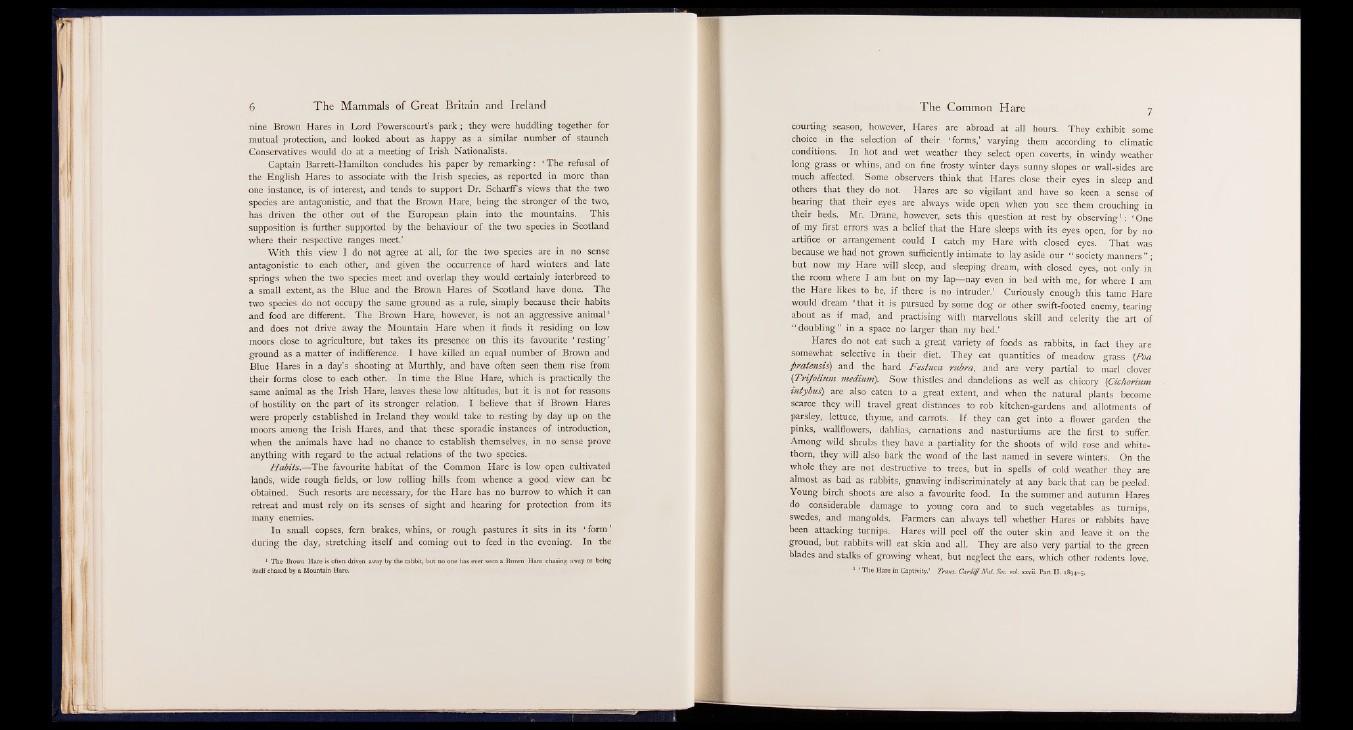
nine Brown Hares in Lord Powerscourt’s park; they were huddling together for
mutual protection, and looked about as happy as a similar number of staunch
Conservatives would do at a meeting of Irish Nationalists.
Captain Barrett-Hamilton concludes his paper by remarking: ‘ The refusal of
the English Hares to associate with the Irish species, as reported in more than
one instance, is of interest, and tends to support Dr. Scharff’s views that the two
species are antagonistic, and that the Brown Hare, being the stronger of the two,
has driven the other out of the European plain into the mountains. This
supposition is further supported by the behaviour of the two species in Scotland
where their respective ranges meet.’
With this view I do not agree at all, for the two species are in no sense
antagonistic to each other, and given the occurrence of hard winters and late
springs when the two species meet and overlap they would certainly interbreed to
a small extent, as the Blue and the Brown Hares of Scotland have done. The
two species do not occupy the same ground as a rule, simply because their habits
and food are different. The Brown Hare, however, is not an aggressive animal1
and does not drive away the Mountain Hare when it finds it residing on low
moors close to agriculture, but takes its presence on this . its favourite ‘ resting ’
ground as a matter of indifference. I have killed an equal number of Brown and
Blue Hares in a day’s shooting at Murthly, and have often seen them rise from
their forms close to each other. In time the Blue Hare, which is practically the
same animal as the Irish Hare, leaves these low altitudes, but it is not for reasons
of hostility on the part of its stronger relation. I believe that if Brown Hares
were properly established in Ireland they would take to resting by day up on the
moors among the Irish Hares, and that these sporadic instances of introduction,
when the animals have had no chance to establish themselves, in no sense prove
anything with regard to the actual relations of the two species.
Habits.— The favourite habitat of the Common Hare is low open cultivated
lands, wide rough fields, or low rolling hills from whence a good view can be
obtained. Such resorts are necessary, for the Hare has no burrow to which it can
retreat and must rely on its senses of sight and hearing for protection from its
many enemies.
In small copses, fern brakes, whins, or rough pastures it sits in its ‘ form ’
during the day, stretching itself and coming out to feed in the evening. In the
1 The Brown Hare is often driven away by the rabbit, but no one has ever seen a Brown Hare chasing away or being
itself chased by a Mountain Hare.
courting season, however, Hares are abroad at all hours. They exhibit some
choice in the selection of their ‘ forms,’ varying them according to climatic
conditions. In hot and wet weather they select open coverts, in windy weather
long grass or whins, and on fine frosty winter days sunny slopes or wall-sides are
much affected. Some observers think that Hares close their eyes in sleep and
others that they do not. Hares are so vigilant and have so keen a sense of
hearing that their eyes are always wide open when you see them crouching in
their beds. Mr. Drane, however, sets this question at rest by observing1 : ‘ One
of my first errors was a belief that the Hare sleeps with its eyes open, for by no
artifice or arrangement could I catch my Hare with closed eyes. That was
because we had not grown sufficiently intimate to lay aside our “ society manners ” ;
but now my Hare will sleep, and sleeping dream, with closed eyes, not only in
the room where I am but on my lap— nay even in bed with me, for where I am
the Hare likes to be, if there is no intruder.’ Curiously enough this tame Hare
would dream ‘ that it is pursued by some dog or other swift-footed enemy, tearing
about as if mad, and practising with marvellous skill and celerity the art of
“ doubling” in a space no larger than my bed.’
Hares do not eat such a great variety of foods as rabbits, in fact they are
somewhat selective in their diet. They eat quantities of meadow grass {Poa
firatensis) and the hard Festuca rubra, and are very partial to marl clover
(Trifolium medium). Sow thistles and dandelions as well as chicory (<Cichorium
intybus) are also eaten to a great extent, and when the natural plants become
scarce they will travel great distances to rob kitchen-gardens and allotments of
parsley, lettuce, thyme, and carrots. I f they can get into a flower garden the
pinks, wallflowers, dahlias, carnations and nasturtiums are the first to suffer.
Among wild shrubs they have a partiality for the shoots of wild rose and whitethorn,
they will also bark the wood of the last named in severe winters. On the
whole they are not destructive to trees, but in spells of cold weather they are
almost as bad as rabbits, gnawing indiscriminately at any bark that can be peeled.
Young birch shoots are also a favourite food. In the summer and autumn Hares
do considerable damage to young corn and to such vegetables as turnips,
swedes, and mangolds. Farmers can always tell whether Hares or rabbits have
been attacking turnips. Hares will peel off the outer skin and leave it on the
ground, but rabbits will eat skin and all. They are also very partial to the green
blades and stalks of growing wheat, but neglect the ears, which other rodents love.
1 ‘ The Hare in Captivity.’ Trans. Cardiff N at. Soc. vol. xxvii. Part II. 1894-5.